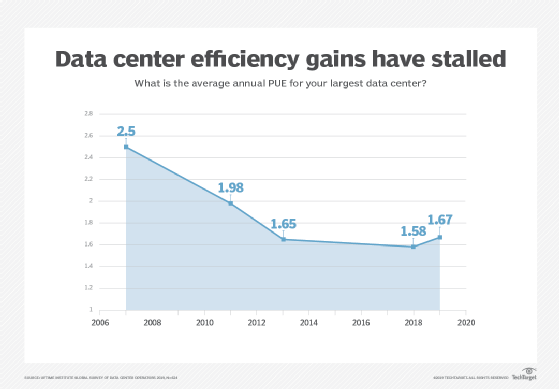
Getty Images/iStockphoto
Data center energy usage combated by AI efficiency
Though often forgotten by the general public, data centers account for 1% of the world's energy consumption. Explore what brought about data centers and how AI can be used to help mitigate their presence.
Data centers have become an important part of our data-driven world. They act as a repository for servers, storage systems, routers and all manner of IT equipment and can stretch as large as an entire building -- especially in an age of AI that requires advanced computing
Establishing how much power these data centers utilize and the environmental impact they have can be difficult, but according to a recent paper in Science Magazine, the entire data center industry in 2018 utilized an estimated 205 TWh. This roughly translates to 1% of global electricity consumption.
Enterprises that utilize large data centers can use AI, advancements in storage capacity and more efficient servers to mitigate the power required for the necessary expansion of data centers.
The rise of the data center
Collecting and storing data is fundamental to business operation, and while having your own infrastructure can be costly and challenging, having unlimited access to this information is crucial to advancements.
Provoking the most coverage because of their massive size, data centers of tech giants like Google and Amazon often require the same amount of energy as small towns. But there is more behind these numbers, according to Eric Masanet, associate professor of Mechanical Engineering and Chemical and Biological Engineering at Northwestern University and coauthor of the aforementioned article.
The last detailed estimates of global data center energy use appeared in 2011, Masanet said.
Since that time, Masanet said, there have been many claims that the world's data centers were requiring more and more energy. This has given policymakers and the public the impression that data centers' energy use and related carbon emissions have become a problem.
Counter to this, Masanet and his colleagues' studies on the evolution of storage, server and network technology found that efficiency gains have significantly mitigated the growth in energy usage in this area. From 2010 to 2018, compute instances went up by 550%, while energy usage increased just 6% in the same time frame. While data center energy usage is on the rise, it has been curbed dramatically through the development of different strategies.
Getting a step ahead of the data center footprint
The workings behind mediated energy increases are all tied to advancements in technology. Servers have become more efficient, and the partitioning of servers through server virtualization has curbed the energy required for the rapid growth of compute instances.
A similar trend is noticeable in the storage of data. While the demand has significantly increased, the combination of storage-drive efficiencies and densities has limited total increase of global storage energy usage to just threefold. To further curb the rising desire for more data and therefore the rising energy costs and environmental impact, companies integrating AI when designing their data centers.

"You certainly could leverage AI to analyze utility consumption data and optimize cost," said Scott Laliberte, a managing director with Protiviti and leader of the firm's Emerging Technologies practice.
"The key for that would be having the right data available and developing and training the model to optimize the cost."
By having AI collect data on their data centers and optimizing the energy usage, these companies can help mitigate the power costs, especially concerning cooling, one of the more costly and concerning of the processes within data centers.
"The strategy changed a little bit -- like trying to build data centers below ground or trying to be near water resources," said Juan José López Murphy, Technical Director and Data Science Practice Lead at Globant, a digitally native services company.
But cooling these data centers has been such a large part of their energy usage that companies have had to be creative. Companies like AWS and GCP are trying new locations like the middle of the desert or underground and trying to develop cooling systems that are based on water and not just air, Murphy said.
Google utilizes an algorithm that manages cooling at some of their data centers that can learn from data gathered and limit energy consumption by adjusting cooling configurations.
Energy trends
For the time being, both the demand for data centers and their efficiency has grown. Now the advancement of servers and storage drives as well as the implementation of AI in the building process has almost matched the growing energy demand. This may not continue, however.
"Historical efficiency gains may not be able to outpace rapidly rising demand for data center services in the not-too-distant future," Masanet said. "Clearly greater attention to data center energy use is warranted."
The increased efficiencies have done well to stem the tide of demand, but the future remains uncertain for data center's energy requirements.







